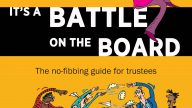Taking the sting out of difficult governance conversations
How do you have conversations with your board without people falling out with each other or being afraid to be honest?
I’ve been working with boards of trustees for many years and one of the things I’ve come to know well is that we can find it very difficult to have truthful conversations about what we really think. Often for really good reasons. We don’t want to offend a fellow trustee by appearing to question their stance on something. We think we ought to know a thing and don’t want to look ignorant. We want to appear supportive. Sometimes the governance and meetings structures we employ mean that at times it’s easier to nod things through from sub-committees because we don’t want to give the impression that we don’t trust our fellow board members or our executive team – or we don’t know how to disagree without appearing arsey.
So genuinely having conversations about how good we are as a board can be really, really hard.
When I’ve facilitated board self-evaluations in the past the truth is that very often the board have a much higher opinion of their performance than the staff do. And it’s not that either is wrong or right – more often that neither side really understands what the other side is judging on. If the board only goes by its own judgement then it is missing feedback which can help it to become even better.
This is why the Governance Code is such a powerful piece of work
It lays down under seven headings the key principles of good governance: organisational purpose; leadership; integrity; decision making, risk and control; board effectiveness; equality, diversity and inclusion and finally openness and accountability.
So how do you use the code to create meaningful conversations with your board without people falling out with each other or being afraid to be honest.
I was facilitating a board who wanted to discuss some key strategic change to how they ran their charity. I asked them what their appetite for change was – they replied pretty good. So it looked like they were all in agreement. I then each of them, “On a scale of 1-10 with 1 being ‘If you change anything I’m off’ and 10 being ‘If you don’t change everything I’m off’ where would you sit?”
You can imagine their absolute shock when they discovered that some of them had scored 3 and some had scored 7 – and the full range in-between. They had no real idea of what each other actually thought. It was only by putting a number on it that they saw the scale of the differences. Mostly importantly we were able to use this difference to engage in a really meaningful conversation about what really mattered.
The point of me asking them to score between 1 and 10 was not the absolute score – it was not the job of the 7s to convince the 3s they were wrong or vice versa – it was to facilitate a conversation so that they could understand what the differences were, why they existed and what it would take to move to unity.
Why is it scored this way?
This trick of scoring 1-10 is a clever way of getting folk to give their truthful view about a thing without it turning into something personal. People, for some reason I don’t fully understand, find it very easy to obfuscate for politeness with words – but find it really difficult to lie when asked to put a number on it. If I ask you how you are you might reply ‘fine’. If I ask you how you are on a scale of 1-10 folk find it really hard to say 8 if they’re feeling 4 – so you have a better chance of getting to the truth of how they really feel.
I’ve been using this technique for years. It’s so successful that we decided at DSC to use this same technique to underpin our new Governance App. You will see when you use it that for each of the questions around the 7 Governance Code priorities trustees and executive staff are asked to score a number of questions on a scale of 1-10. This is then collated and the board are given the results.
The absolute scores are not what matters – what matters is that you establish where there are differences so that you as a board can have an open, relatively conflict free, discussion about why and what you need to do to move forward.
Similarly if you all agree that you score say 4 or 5 on one question but you think you really ought to be scoring 8 or 9 then that gives you the space to have the conversation about what it would take to move from 4 to 8. So do some of you score 8 on clarity of organisational purpose and others score only 4? Or some of you score 7 on how good you are at risk and others only 2? Knowing these differences and establishing a common understanding makes for profound and meaningful conversations which help your charity to excel.
Having conversations about governance can be hard to initiate and even harder to manage
The Governance App takes the sting out of it. It provides a framework so that you can develop an action plan, unique to you, about what it is to be the best possible board you can be – which I know most of us trustees aspire to.
It’s worth the effort. Give it a go. And if you need any help or advice on how to structure your conversations once your Board and executive team have completed the questionnaire get in touch – we’re happy to help.



